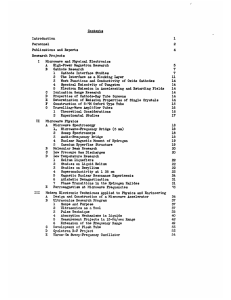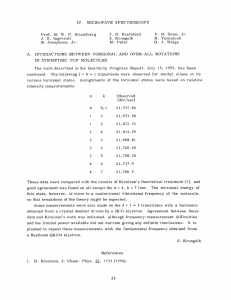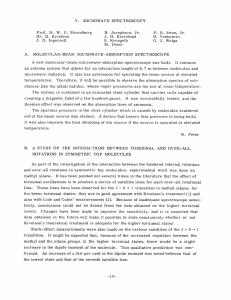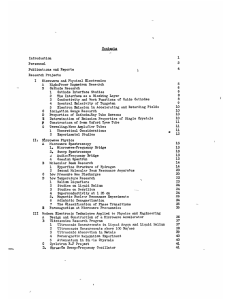IV. MICROWAVE SPECTROSCOPY B. Josephson, Jr.
advertisement
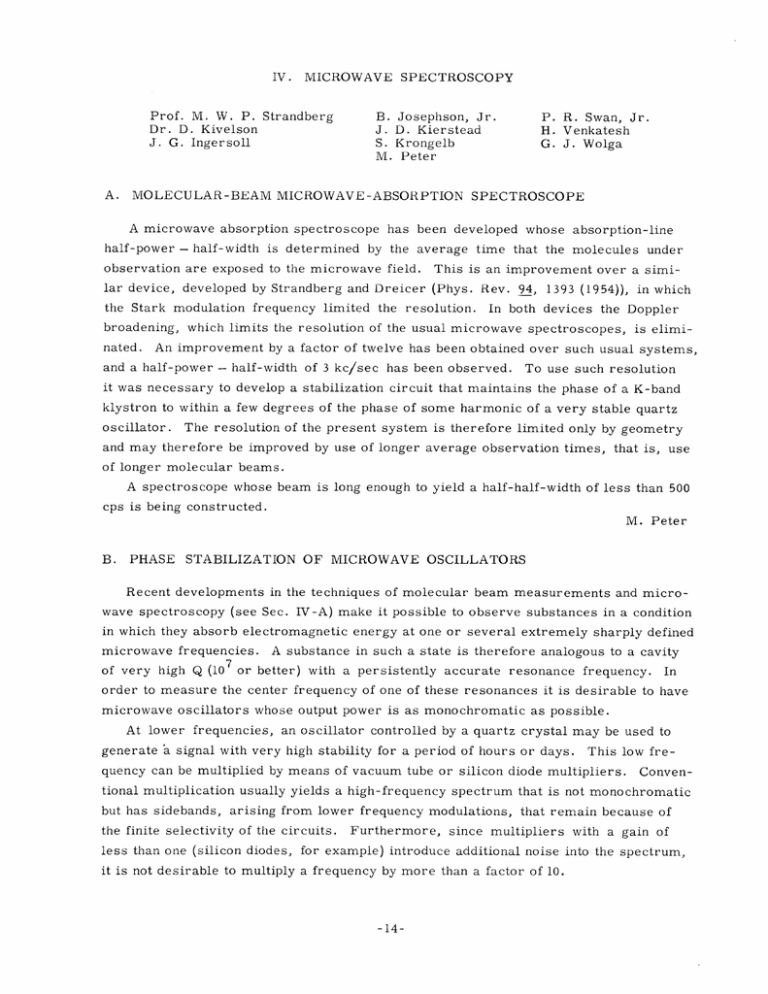
IV. MICROWAVE Prof. M. W. P. Strandberg Dr. D. Kivelson J. G. Ingersoll A. SPECTROSCOPY B. Josephson, Jr. J. D. Kierstead S. Krongelb M. Peter MOLECULAR-BEAM MICROWAVE-ABSORPTION P. R. Swan, Jr. H. Venkatesh G. J. Wolga SPECTROSCOPE A microwave absorption spectroscope has been developed whose absorption-line half-power - half-width is determined by the average time that the molecules under observation are exposed to the microwave field. This is an improvement over a simi- lar device, developed by Strandberg and Dreicer (Phys. Rev. the Stark modulation frequency limited the resolution. broadening, nated. 94, 1393 (1954)), in which In both devices the Doppler which limits the resolution of the usual microwave spectroscopes, is elimi- An improvement by a factor of twelve has been obtained over such usual systems, and a half-power - half-width of 3 kc/sec has been observed. To use such resolution it was necessary to develop a stabilization circuit that maintains the phase of a K-band klystron to within a few degrees of the phase of some harmonic of a very stable quartz oscillator. The resolution of the present system is therefore limited only by geometry and may therefore be improved by use of longer average observation times, that is, use of longer molecular beams. A spectroscope whose beam is long enough to yield a half-half-width of less than 500 cps is being constructed. M. B. PHASE STABILIZATION OF MICROWAVE Peter OSCILLATORS Recent developments in the techniques of molecular beam measurements and microwave spectroscopy (see Sec. IV-A) make it possible to observe substances in a condition in which they absorb electromagnetic energy at one or several extremely sharply defined microwave frequencies. A substance in such a state is therefore analogous to a cavity of very high Q (107 or better) with a persistently accurate resonance frequency. In order to measure the center frequency of one of these resonances it is desirable to have microwave oscillators whose output power is as monochromatic as possible. At lower frequencies, an oscillator controlled by a quartz crystal may be used to generate a signal with very high stability for a period of hours or days. This low fre- quency can be multiplied by means of vacuum tube or silicon diode multipliers. Conven- tional multiplication usually yields a high-frequency spectrum that is not monochromatic but has sidebands, arising from lower frequency modulations, the finite selectivity of the circuits. Furthermore, that remain because of since multipliers with a gain of less than one (silicon diodes, for example) introduce additional noise into the spectrum, it is not desirable to multiply a frequency by more than a factor of 10. -14- (IV. MICROWAVE SPECTROSCOPY) A circuit has been developed with which microwave oscillators may be phase-locked to weak but stable reference signals. It has operated with S-band oscillators (707B klys- tron; 2C37 triode oscillator) and a 2K50 K-band klystron. It is possible to lock a micro- wave oscillator directly or through a cascade of such circuits to a quartz-stabilized The statistical theory of random noise is used to obtain an analysis of oscillator. the stabilizing effect of the circuit, and the power spectrum of the stabilized microwave source is calculated. The scheme can also be applied in divider operation. A modified circuit that uses carrier-suppressed modulation of the reference signal has also been In another circuit, the oscillator frequency is converted by means of a stable realized. and compared with a second reference that can be of low frequency and tun- reference, able. These latter circuits allow elimination of the excess noise introduced by crystal diodes. In the original straight dc circuit this noise cannot be eliminated, but calcula- tion shows that its influence on the output power spectrum is very small. M. Peter C. EXCITED TORSIONAL STATES IN ASYMMETRIC HINDERED ROTORS The J = 0 -* 1 transition of methyl alcohol is being investigated. torsion in this type of molecule the transition is split into a doublet corresponding to a particular internal torsion state. Because of internal series of doublets, each A preliminary model was that of a rigid symmetric top attached at an arbitrary angle to a rigid asymmetric frame and allowed to rotate about its symmetry axis under the influence of a threefold cosine potential barrier. The resulting Hamiltonian was found to be incapable of predicting the torsional splitting when applied to the methyl alcohol molecule. bination of Kivelson's formula (J. Chem. Phys. 22, A semiempirical com- 1733 (1954)) for the corresponding transition in a symmetric hindered rotor with matrix elements from this methyl alcohol Hamiltonian was found to give a close fit to the observed spectrum. An additional fea- ture of the methyl alcohol spectrum is the large fourth-order Stark effect of one of the lines of the J = 0 -* 1 series. A generalized potential is being developed to describe these excited torsional levels. P. D. R. Swan, Jr. PARAMAGNETIC RESONANCE The paramagnetic resonance spectrograph was adapted for examination of unstable gaseous molecules. A resonant microwave cavity was designed and fitted with a quartz liner that will contain the gaseous sample. A rapid-flow technique is contemplated for introducing the gas into the cavity. G. J. -15- Wolga, D. Kivelson

